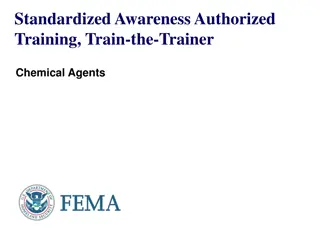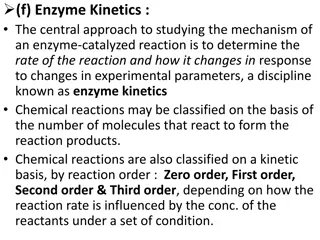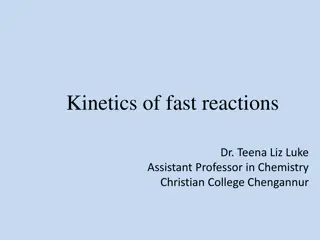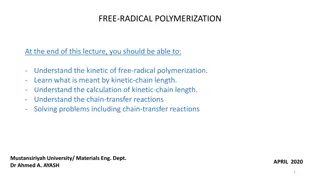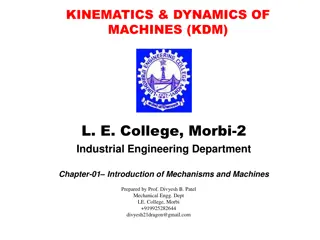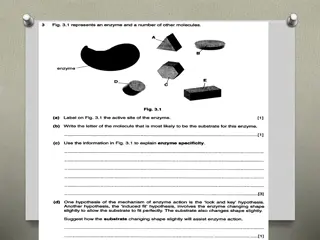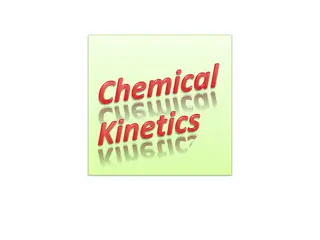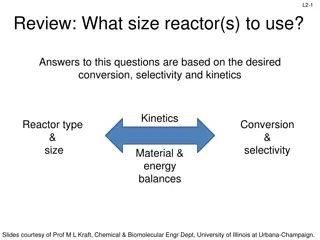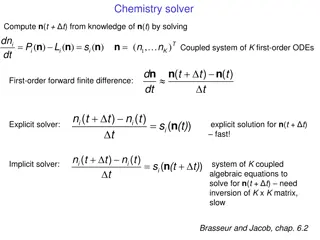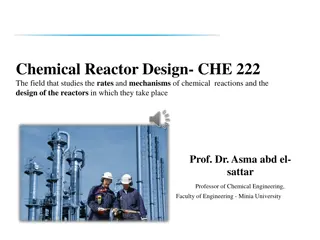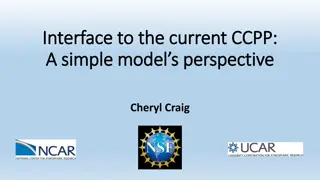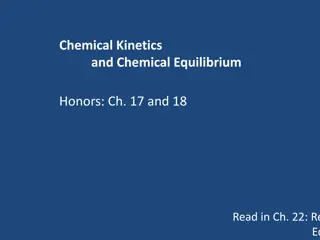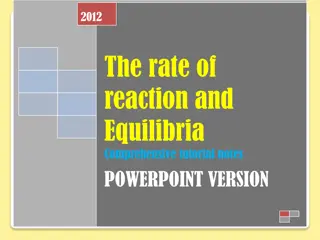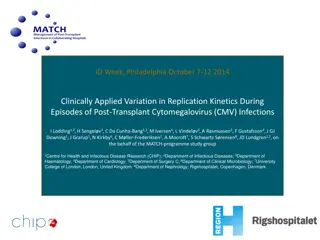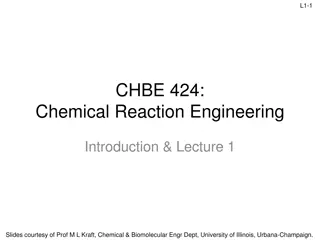Chemical Kinetics
Chemical kinetics is the study of reaction rates in chemical systems, influenced by factors like concentration, temperature, and catalysts. Explore various chemical and biochemical reactions, including the Law of Mass Action, reaction equilibrium, and deriving equilibrium values, through detailed explanations and images from a workshop led by Nancy Griffeth.
Download Presentation

Please find below an Image/Link to download the presentation.
The content on the website is provided AS IS for your information and personal use only. It may not be sold, licensed, or shared on other websites without obtaining consent from the author.If you encounter any issues during the download, it is possible that the publisher has removed the file from their server.
You are allowed to download the files provided on this website for personal or commercial use, subject to the condition that they are used lawfully. All files are the property of their respective owners.
The content on the website is provided AS IS for your information and personal use only. It may not be sold, licensed, or shared on other websites without obtaining consent from the author.
E N D
Presentation Transcript
Chemical Kinetics Nancy Griffeth January 8, 2014 Funding for this workshop was provided by the program Computational Modeling and Analysis of Complex Systems, an NSF Expedition in Computing (Award Number 0926200).
What is chemical kinetics The study of the rates at which chemical reactions take place Factors to consider Concentration Temperature Presence of catalysts
Reaction rates The rate of a chemical reaction is a measure of how the concentration (or pressure) of the involved substances changes with time.
Chemical Reactions 2Na + Cl2 2 NaC table salt S + O2 SO2 sulfur dioxide 4 Fe + 3 O2 2 Fe2O3 iron rusting CO2 + H2O H2CO3 carbon dioxide dissolving and reacting with water to form carbonic acid
Biochemical Reactions Aerobic Respiration Glucose+Oxygen CarbonDioxide+Water +Energy C6H12O6+ 6O2 6CO2 + 6H2O + energy Anaerobic Respiration C6H12O6 2C2H5OH+2CO2 + Energy Glucose Ethanol+CarbonDioxide+Energy Metabolism of ethanol Ethanol Acetaldehyde CH3CH2OH + NAD+ CH3CH=O + NADH + H+
Rates Part I: The Law of Mass Action Rate: .039/sec CO2 + H2O H2CO3 Reaction: Define: [A] = concentration of A (e.g., moles per liter) d[H2CO3] dt = k+[CO2][H2O] = .039[CO2][H2O]
The Law of Mass Action .039/sec Forward Rate: CO2 + H2O H2CO3 Backward Rate: 23/sec Reaction: d[H2CO3] dt = k+[CO2][H2O] - k-[H2CO3] = .039[CO2][H2O] - 23[H2CO3]
Reaction Equilibrium At equilibrium, the instantaneous forward rate equals the instantaneous reverse rate. k+[CO2][H2O] - k-[H2CO3] = 0 [CO2][H2O] k- [H2CO3] k+ = = K K = 23/.039 ~ 590 Since the equilibrium constant is large, we can predict that very little carbonic acid forms.
Deriving Equilibrium Values In the absence of other reactions involving CO2 and H2CO3, the quantity [CO2]+[H2CO3] = A0 is conserved. We can use this to compute various things: [H2O]eq K + [H2O]eq K K + [H2O]eq [H2CO3]eq = A0 [CO2]eq = A0
Forming Dimers M is a monomer D is a dimer k+ M + M D k- d[M] dt = 2k-[D] - 2k+[M][M]
Forming Dimers - Exercise d[M] dt d[D] dt = 2k-[D] - 2k+[M]2 = -k-[D] + k+[M]2 = -1/2 d[M] d[D] dt dt [M] + 2[D] is conserved
Organic Chemical Reactions Phosphorylation Example of enzymatic action
Enzyme Kinetics A kinase is an enzyme Enzymes are catalysts that make reactions faster Catalytic power Specificity Regulation Can increase speeds up to 1 million times
Enzyme Kinetics Enzymes don t follow the law of mass action directly By the law of mass action, the rate of S+E->P+E would increase linearly with increasing [S] In enzymatic reactions, the rate increases less than linearly with the increase in S and reaches a maximum
Rate Laws: Enzymatic Action Instead of S+E P+E the reaction creates a complex SE from the substrate and enzyme, followed by dissociation of the complex into the product and the enzyme.
Enzymatic Action Assumption 1: The enzyme forms a complex with the substrate, from which the product is formed. Exercise: What is the chemical formula? k1 k2 E+S ES E+P k-2 k-1
Enzymatic Action Assumption 2: The product doesn t react with the enzyme. Exercise: How does this change the formula? k1 k2 (k-2 = 0) E+S ES E+P k-1
Rate Laws: Enzymatic Action Let s=[S] (substrate), e=[E] (enzyme), c=[ES] (complex), p=[P] (product
Exercises Rate of change of substrate: ds dt= -k1se + k-1c Rate of change of complex: dt= k1se - k-1c - k2c dc Rate of change of enzyme: de dt= -k1se + k2c + k-1c Rate of change of product: dp dt= k2c
Quasi-steady State Approximation Assumption 3: The concentration of the complex changes much more slowly than the concentrations of the substrate and the product Exercise: How would you model this? dc dt= k1se - k-1c - k2c 0
Quasi-steady State Approximation Assumption 4: The enzyme concentration doesn t change over time. Exercise: How would you model this? e0 = e + c is a constant
Exercise Using e0 = e + c is a constant and dc dt= k1se - k-1c - k2c 0 dp dt compute (the rate of change of the concentration of the product) as a function of s (the concentration of the substrate).
Answer to Exercise s dp dt = k2 e0 k2 + k-1 k1 + s k2 + k-1 k1 Let KM = and vmax = k2 e0 dp dt s Then = vmax KM + s
Consequences What can we say about the reaction if: s << KM? s KM? s >> KM? s Hint: Look at KM + s
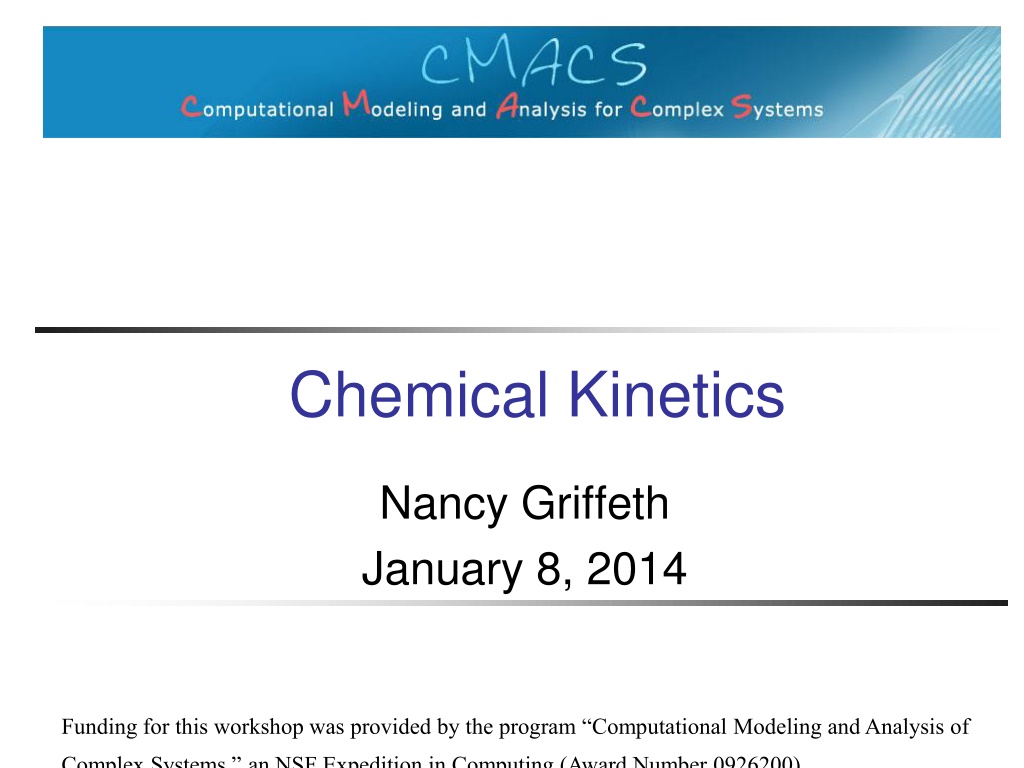
 undefined
undefined





